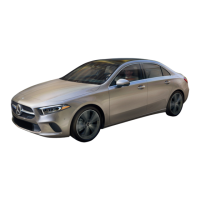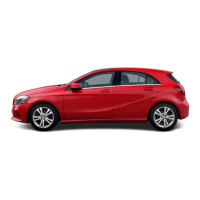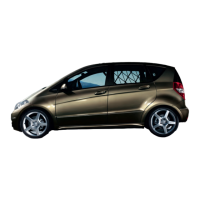Key positions
g
To remove the key
1
Powersupply for some consumers, such
as the windscreenwipers
2
Ignition (power supply for all consumers)
and drive position
3
To start the engine
i
The key can be turned in the ignition lock
even if it is not the correctkey for the vehi-
cle. The ignition is then not switched on.
The engine cannot be started.
Starting the engine
Important safety notes
G
Risk of poisoning
Never leave the engine running in enclosed
spaces. The exhaust gases contain carbon
monoxide. Inhaling exhaust fumes consti-
tutes a health hazard and could lead to loss
of consciousness or even death.
!
Do not depress the accelerator pedal
when starting the engine.
Manual transmission
X
Depress the brake pedal and keep it
depressed.
X
Fully depress the clutch pedal.
X
Shift to neutral N.
i
You can only start the engine when the
clutch pedal is fully depressed.
AUTOTRONIC
X
Shift the transmission to position P.
i
You can also start the engine when the
transmission is in position N.
Starting procedure
X
To start a petrol engine: turn the key to
position 3 in the ignition lock
(Y page 111) and release it as soon as the
engine is running.
X
To startadiesel engine: turn the key to
position 2 in the ignition lock
(Y page 111).
The % preglow indicator lamp in the
instrumentcluster lights up.
X
When the % preglow indicator lamp
goes out, turnthe key to position 3
(Y page 111) and release it as soon as the
engine is running.
i
You can start the engine without preglow
if the engine is warm.
i
Vehicles with AUTOTRONIC: you can
also use the touch-start function. To do
this, turn the key to position 3
(Y page 111) and release it immediately.
The engine then starts automatically.
Pulling away
Manual transmission
X
Depress the brake pedal and keep it
depressed.
X
Fully depress the clutch pedal.
X
Shift to either first gear or reverse gear R.
X
Release the parking brake (Y page 128).
X
Release the brake pedal.
X
Slowly release the clutch pedal and gently
depress the accelerator pedal.
!
Change gear in good time and avoid spin-
ning the wheels. Otherwise, you could dam-
age the vehicle.
Driving
111
Driving and parking
Z

